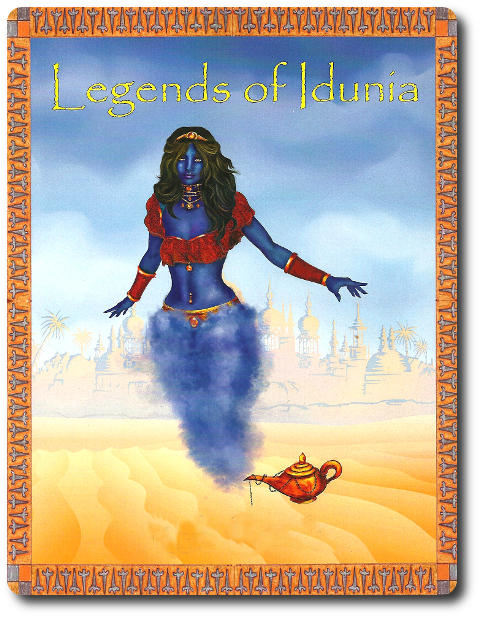
The Basics:
- For ages 6 and up (publisher suggests 12+)
- For 1 to 3 players
- Approximately 90 minutes to complete
Geek Skills:
- Active Listening & Communication
- Counting & Math
- Logical & Critical Decision Making
- Reading
- Strategy & Tactics
- Risk vs. Reward
- Cooperative & Team Play
- Hand/Resource Management
Learning Curve:
- Child – Easy
- Adult – Easy
Theme & Narrative:
- Fate is fickle and good fortune is random
Endorsements:
- Gamer Geek rejected!
- Parent Geek mixed!
- Child Geek approved!
Overview
A mutinous crew have tossed you and two companions overboard. You are now adrift in a small boat with nothing but ocean to be seen. Death will come soon, but fate is fickle and easily misinterpreted. Adventure awaits you on a distant shore growing larger on the horizon.
Legends of Idunia, designed by Fabian Schurgers and published by Fasold Games via the Game Crafter, is comprised of 1 game board, 3 Hero cards, 1 Treasure & Water card, 1 Enemy Life Points & Location card, 9 Skill cards, 2 Quest cards, 26 Treasure cards, 5 Starting Equipment cards, 6 Monster Day cards, 6 Monster Night cards, 1 Storybook, 25 markers, 1 pawn, 1 four-sided die, 1 six-sided die, 1 eight-sided die, and 1 twenty-sided die. The cards are as thick and as durable as your standard playing cards. The game board is made of thick cardboard. The Story Book is soft cover with a font that furthers the game’s theme, but is still easy to read.
Adventure Set Up
To set up the game, first place the game board in the middle of the playing area.
Second, have each player select 1 Hero card. If there are only 2 players, 1 player will need to select 2 Hero cards. If there is only 1 player, all 3 Hero cards are still used during the game.
Third, assigning starting Equipment and Skill cards to the Hero cards.

- Rogue: 2 “Dagger” Starting Equipment cards, 1 “Dodge” Skill card, 1 marker on the Level “1” spot on the Skill card, and 1 marker on the “12” Life Points spot on the Hero card.
- Wizard: 1 “Fireball Spell” Starting Equipment card, 1 “Frostbite Spell” Starting Equipment card, 1 “Meditation” Skill card, 1 marker on the Level “1” spot on the Skill card, and 1 marker on the “10” Life Points spot on the Hero card.
- Warrior: 1 “Longsword” Starting Equipment card, 1 “Power Attack” Skill card, 1 marker on the Level “1” spot on the Skill card, and 1 marker on the “14” Life Points spot on the Hero card.
Fourth, place the pawn (which represents all 3 Heroes in the game) on the camp symbol found on the game board and 1 marker on the left-most day position on the Timeboard (indicating the first hour of the first day).
Fifth, place 1 marker on the “4” spot of the Water Supply track found on the Treasure & Water card.

Sixth, separate the Treasure and Monster cards by type and shuffle each, placing the decks face-down next to the game board. These are the individual draw decks for the duration of the game. Place the Enemy Life & Location card next to the Treasure & Water card. The dice should remain off to one side of the game board until needed. Extra markers can be put next to the dice.
That’s it for game set up. Time to see if this adventure has a happy ending.
Desert, Doom, and Dialog
Legends of Idunia is played in rounds with no set number of rounds per game. This is a cooperative game where the players will all win or all lose. Decisions need to be made as a team, but each player decides how their own individual Hero will resolve conflicts and take actions.
The game play is a mix of storytelling, choose your own adventure decision making, and exploration. The game begins by reading a short introduction that sets the stage and first objective. From there, it’s up to the players to decide what to do next. Regardless of their choices, each round of game play is comprised of several sequential steps, which are summarized here.
Step 1: Travel
The six-sided die is used to determine how many spaces the pawn can move during the round. If a “1” is rolled, the die is rolled again. Movement across the land is restricted to sand dunes, dry earth, and palm trees. This terrain is indicated on the game board using symbols. Each symbol is equivalent to 1 movement. The players can work together to determine where they should visit and then move the pawn to the new location on the map.

As the game progresses, the players will acquire a boat that will allow them to move the pawn to nearby islands. The only restriction to travel the ocean is that players cannot travel on land and then sea in a single round.
Plays can also “jump” from one previously visited fixed location to another previously visited fixed location without rolling the dice. Players will still lose time and water, but the act of “jumping” provides for a much more direct route of travel. While using this method of travel, the players have a 50/50 chance of bumping into a random encounter by drawing 1 Monster Day or 1 Monster Night card, per the time of day they are traveling.
Step 2: Adjust Time & Water Supply
When the marker moves from day to night or from night to day, the players reduce their Water Supply value by -1. It’s always reduced no matter how far the distance the player’s travel. If the player’s Water Supply is reduced to zero, each Hero suffers -3 Life Point when they travel. In addition, players cannot rest their Heroes to regain health. Heroes can regain water by visiting an Oasis on the map or stumbling upon water while traveling.
The marker is reset to the first Sun spot when it moves off the Timeboard. In this way, the players will be cycling through night and day during their adventure.
Step 3: Resolve Encounter
The cycle of the Sun and the Moon is kept track of during the game, as the time of day influences encounters. That is, a relativity harmless looking deserted home during the day might be the home of hungry monsters at night.
Moving on land requires the players to move the marker on the Timeboard 1 spot to the right. Moving on water requires the players to move the marker 2 spots to the right. As long as the marker is on a spot where the symbol is the Sun, it remains day. When the marker is on a spot with the Moon symbol, the land is dark and a dangerous place.
There are 2 types of encounters in the game. These are fixed and random.
Fixed encounters take place at special locations (referred to as “story locations”) on the map. The Storybook describes the location and the encounter, based on the time of day. These are important places the players must visit if they are to advance the plot. Random encounters are indicated by a question mark on the map. The twenty-sided die is rolled and the results are compared to a table in the Storybook that determines what the Heroes find. If the resulting value rolled indicates an encounter that has already been completed, the die is rolled again. Random encounters are also provided by drawing the Monster cards when “jumping” between fixed locations.
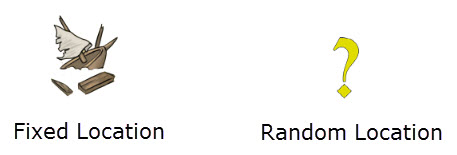
In either case, 1 player must take up the Storybook and read the encounter details to the rest of the players. This is done out loud and may require the players to make decisions and engage in combat. The time of day the location is visited will also influence the encounter. Or the players will reveal a Monster card and flip it over so all players can see it.
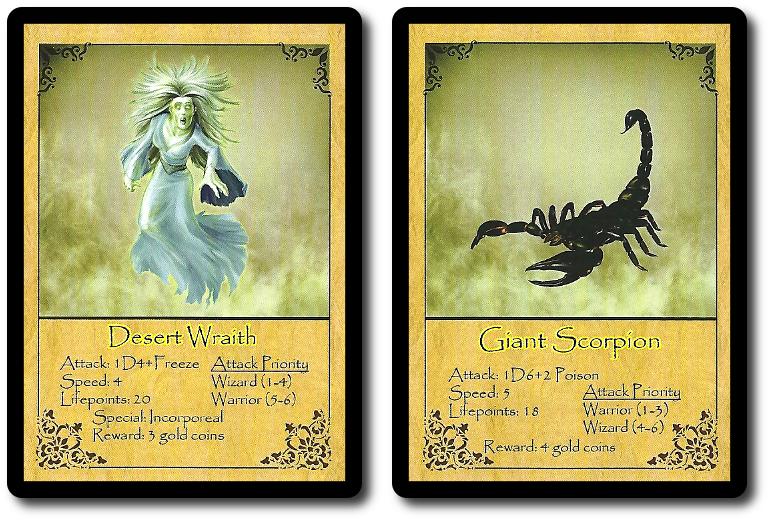
Monsters have the following statics:
- Attack: The number of dice rolled and any additional effects (poison, for example)
- Speed: Determines the turn order sequence of attacks
- Life Points: Amount of damage that can be taken before the monster falls
- Reward: Loot gained after successfully defeating the monster
- Attack Priority: Determines which Hero the monster will attack
- Special: Any additional rules that apply to the monster
The monster’s Life Points are tracked on the Enemy Life Points & Locations card. Combat is completed using rounds. The first round is dedicated to ranged attacks and will only happen once per battle. All attacks are simultaneous. The next round is dedicated to melee and hand-to-hand combat. Swords, daggers, and spells can now be used.
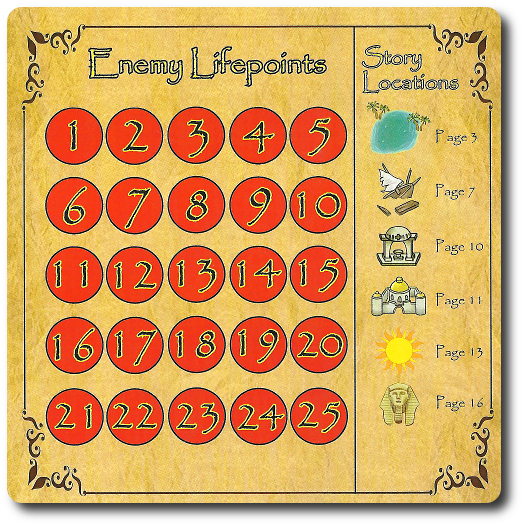
Spells are a double-edged sword in the game. Depending on what monster is attacking the Heroes, the spell might not have any effect. For example, a monster immune to fire will shrug off a “Fireball Spell” Skill card. A practitioner of magic must know how to use it to penetrate an enemy’s weakness. Luckily for magic users, there is no limit to the number of spells that can be learned.
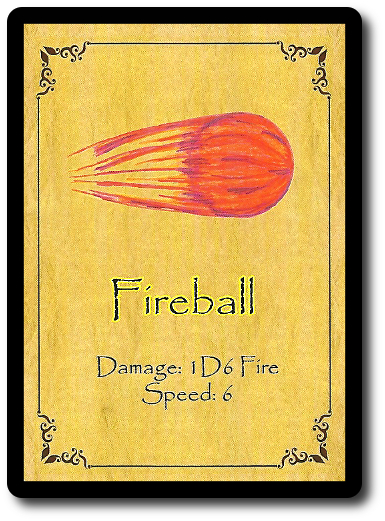
During the second round of combat, the player or monster with the lowest Speed value goes first, followed by the second lowest and so on. When a player or enemy attacks, they roll the dice indicated for their Attack and the resulting value is the damage dealt, reducing the Life Points accordingly. If the monster’s Life Points drop to zero, it’s defeated. If a Hero’s Life Points drop to zero, they are considered critically injured and cannot participate for the rest of the battle.
Players can also use Items and Skills. Skills can only be used once per combat and are paired with a weapon, resulting in a more powerful attack. Skills can also be used to influence the attacks of the enemy. As the game progresses, the players can improve their Skills to make them even more powerful.
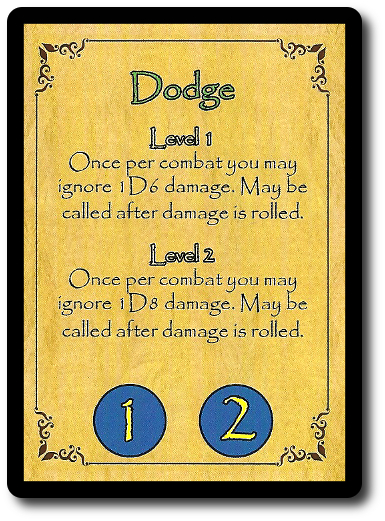
Weapons will increase the damage dealt and armor will reduce it. Some monsters have a special effect that cannot be blocked by any armor, requiring the player to successfully complete a Challenge. A Challenge requires the player to roll a six-sided die. If the result of the roll is higher than the Challenge number of the enemy, the Hero resists the effect of the monster’s attack.
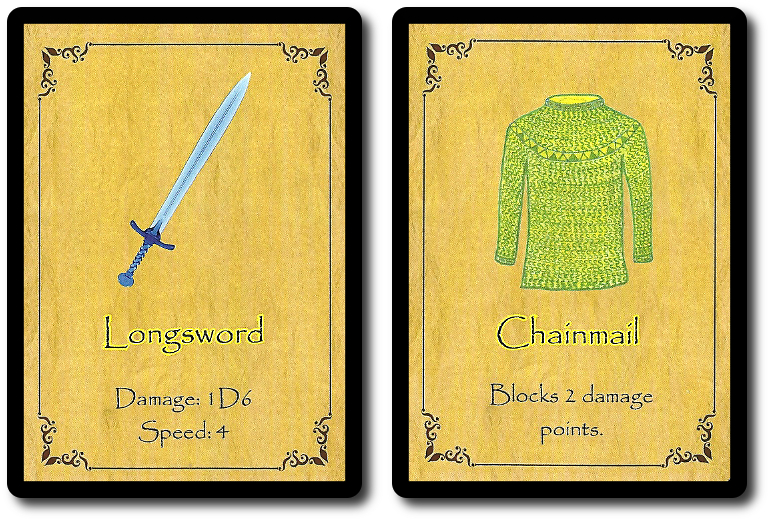
There will be situations where the Heroes will have to fight more than 1 monster at a time. In this case, combat is the same, but the Life Points of the multiple monsters are tracked separately.
Combat continues until either the enemy is dead or the Heroes are. If the Heroes win, they will be given gold that can be used to upgrade equipment and obtain new abilities. Gold earned is tracked on the Treasure & Water Supply card, but the gold can only be used at certain locations. For example, the Traders. Heroes can also find Treasure and Quest items that are necessary to win the game.
Step 4: Resting
Resting is only possible after an encounter and mandatory if at least 1 Hero is critically injured. Resting takes time (2 spaces on the Timeboard) and water is consumed. If resting is successful, all Heroes regain all of their Life Points.
This completes a round of game play. The next round now begins starting with step 1 noted above.
Winning and Losing the Game
Players lose if 1 or more Heroes have become critically injured (Life Points drop to zero) and their is no more water in the Water Supply to allow for resting. The legend of the Heroes will be lost in the sand and for all time, never to be remembered.
Players win if they are able to figure out how to escape the Great Desert. The legend of the Heroes is just beginning, however. All acquired gold, Skills, and equipment can be used in the next chapter of the game (not yet released as of this review), allowing the players to continue their adventure with the same Heroes.
To learn more about Legends of Idunia, visit the game’s web page.
Final Word
For the Child Geeks, Legends of Idunia was a big hit. The adventure kept them hooked, the random encounters kept them on edge, and the need to watch their water supply made them push the limits, but always within reason. According to one Child Geek, “I like this game because it reminds me of the pick-a-path books I read at night-time.” Another Child Geek said, “It’s pretty neat. It’s a board game and a role-playing game all in one.” None of the Child Geeks found it difficult to learn how to play and even younger Child Geeks who could not yet read well enough to lead the adventure on their own were able to have a great time. Best of all, the game could be “paused” and left until the next morning, allowing players to take their time and not worry about rushing to finish a quest. When all the games were over, the Child Geeks voted to approve Legends of Idunia.
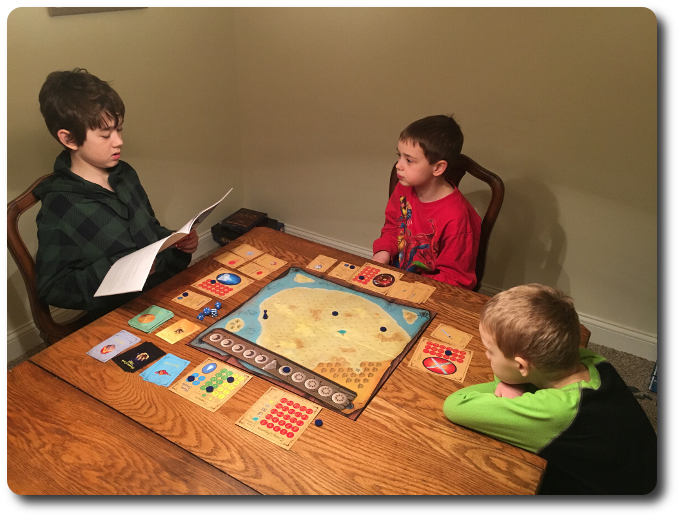
My oldest son reads the encounter details, while his two younger brothers listen intently
The Parent Geeks didn’t much care for the game when they played it with their peers. According to one Parent Geek, “It’s very weird to be reading to both of your friends when they are adults.” They also didn’t find the game to be that challenging. As one Parent Geek put it, “The only challenging aspect of the game is managing life and water, which are both easy.” When Legends of Idunia was played with the Child Geeks, the Parent Geeks praised the game, finding it to be entertaining and an adventure everyone could enjoy. According to one Parent Geek, “This game reminds me of the ones I played as a kid, but with pen and paper. I like how everything I need is in a box and easy for me to play with my kids.” The Parent Geeks gave the game a mixed level of approval, highly recommending it as a game for the family, but not something of interest among adults.
The Gamer Geeks found Legends of Idunia to be a rather ambitious projects. According to one Gamer Geek, “The designer has created a role-playing rule system that works very well as a board game.” The Gamer Geeks didn’t think the writing was too bad, either. As one Gamer Geek put it, “It can be difficult to tell a story that keeps the players interested. This game has a pretty good story, if not altogether somewhat predictable.” What the Gamer Geeks didn’t like was how easy the game was to win. According to one Gamer Geek, “This isn’t a very complicated game. I feel that it replaced length of play with depth of play. Moving around the board feels totally unnecessary most of the time.” The Gamer Geeks didn’t find the game to be legendary and voted to reject it.
Legends of Idunia provides its players a cooperative adventure using an easy to learn and to use set of rules that keep the game going. Along the way, the players must manage not only their Hero, but the party, and their supplies. Moving across the desert is an exercise in logistic and resource management. Combat with monsters is deftly done, with quick rolls and even quicker results. The Story Book provides an engaging plot and drops the players into the adventure, wherein they decide the course of the narrative.
All great stuff and limiting. Legends of Idunia is a game that has little reason to be played after you complete it. Random cards aside, there is not enough to the game to provide a great deal of replayability. A group of players might find themselves playing the game again and again, but when they successfully complete it, there is little need to visit the Great Desert, as it no longer holds any mystery. Not a bad thing, but a game’s level or replayability suggests the frequency it will hit the table and be enjoyed. Important to some and hardly a consideration to others.
But Legends of Idunia is not your average board game, so we must take that into account. I liken it more of an “Adventure in a Box”, where everything you need to enjoy a fantasy adventure is provided. And do play it with others. You can play the game alone, but the fun comes from cooperatively experiencing the adventure with friends. There are many rememberable moments to be had. Close calls, spectacular hits, and mysteries to solve.
I would recommend Legends of Idunia to those who are looking to teach others what role-playing is all about or want a game where cooperation is necessary to defeat the odds and randomly encountered monsters. This is not a game for elitists, but it will entertain Child Geeks and their hero Parent Geeks if played together.
This game was given to Father Geek as a review copy. Father Geek was not paid, bribed, wined, dined, or threatened in vain hopes of influencing this review. Such is the statuesque and legendary integrity of Father Geek.



